Lettre d’information de l’Ifao
Janvier 2025
Rubriques : (-) À la une (-) Vie au Palais (-) Formations scientifiques et enseignements (-) Quelques questions à Séverine Marchi... (-) Le carnet de l'Ifao (-) Manifestations scientifiques (-) Rencontres scientifiques (-) Sur la chaîne Youtube de l'Ifao (-) Publications

◼︎ Inauguration de la salle Hesy-Rê au Musée du Caire (salle 27), le 12 octobre 2024 © Ifao.
À la Une
|
L’ensemble du personnel de l’Ifao vous souhaite une excellente année 2025, pleine de bonheur, de fructueuses collaborations et de réussites. يتمنى لكم جميع العاملين في المعهد الفرنسي للآثار الشرقية عاماً ممتازاً ٢٠٢٥ مليئاً بالسعادة والتعاون المثمر والنجاح Inauguration de la salle Hesy-RêCette rentrée a été marquée par l'inauguration de la salle Hesy-Rê au Musée du Caire (salle 27), destinée à accueillir des objets figurant parmi les plus uniques des collections de ce grand Musée : les panneaux en bois du mastaba de Hesy-Rê. L'oeuvre est le fruit d’un projet conjoint dirigé par Anita Quiles et débuté en 2021, entre le Musée égyptien du Caire et le département d'archéométrie de l'Ifao, avec le soutien de l'Institut français d'Égypte et de la Fondation Michela Schiff Giorgini. Le projet a donné lieu à l'étude, la restauration, la conservation et la réexposition des panneaux en bois de Hesy-Rê dans leur contexte d’origine, d’une manière à permettre aux visiteurs du musée de pénétrer dans une partie restituée de la tombe de ce dignitaire telle qu'elle avait été pensée par ses constructeurs à Saqqara, celle-ci n'ayant pu être conservée. (Cliquez ici pour une vue 360° de la salle). C'est lors d'une cérémonie organisée au Musée le soir du samedi 12 octobre que cette nouvelle salle a été inaugurée par le secrétaire général du Conseil suprême des antiquités (CSA), Dr. Mohamed Ismail, l’ambassadeur de France en Égypte, Eric Chevallier, en présence de Dr. Zahi Hawas et Dr Mamdouh el-Damaty, anciens ministres des antiquités, Dr. Moamen Osman, chef du secteur des musées au CSA, Dr Ali Abdel Halim, directeur général du Musée égyptien, ainsi que des ambassadeurs, des directeurs d'instituts archéologiques en Égypte, des professeurs d'université et des personnalités publiques. |
◼︎ La salle Hesy-Rê ©I. Ibrahim/Ifao
|
|
|
شهد شهر أكتوبر ٢٠٢٤ افتتاح قاعة « حسي رع » في المتحف المصري بالتحرير (القاعة ٢٧)، لتضم بعضًا من أكثر القطع الفريدة في مجموعات هذا المتحف العظيم: اللوحات الخشبية لـ« حسي رع ». هذا العمل هو ثمرة مشروع مشترك، بدأ في عام ٢٠٢١، بين المتحف المصري وقسم الأركيومتري بالمعهد الفرنسي للآثار الشرقية، بدعم من المعهد الفرنسي بمصر ومؤسسة ميشيلا شيف جيورجيني. تضمن المشروع دراسة وترميم وحفظ وإعادة عرض اللوحات الخشبية لمصطبة حسي رع بطريقة مبتكرة تمكن زوار المتحف من مشاهدة هذه اللوحات في سياقها الأصلي، كما صممها بناة المصطبة في سقارة، داخل محاكاة لجزء من المصطبة تم أعادة بناءه. تم افتتاح القاعة الجديدة في حفل أقيم بالمتحف مساء السبت ١٢ أكتوبر بحضور الأمين العام للمجلس الأعلى للآثار، الدكتور محمد إسماعيل، وسعادة السفير الفرنسي في مصر، السيد إيريك شوفالييه، والسيد الدكتور زاهي حواس و السيد الدكتور ممدوح الدماطي، وزيرا الآثار السابقين، والسيد الدكتور بيير تاليه مدير المعهد الفرنسي للآثار الشرقية والسيد الأستاذ مؤمن عثمان رئيس قطاع المتاحف والسيد الدكتور علي عبد الحليم مدير عام المتحف المصري والعديد من السفراء ومديري المعاهد الأثرية في مصر وأساتذة الجامعات والشخصيات العامة. |
||
Séminaire annuel du Réseau des Écoles françaises à l’étrangerCe même mois d’octobre s’est achevé sur le séminaire annuel du Réseau des Écoles françaises à l’étranger (ResEFE) qui s’est tenu à Paris au siège de l’École française d’Extrême-Orient. Il était consacré aux archives des Écoles, dix ans après une première rencontre sur ce sujet. À cette occasion, une présentation des archives et des collections de l'Ifao par Cédric Larcher, responsable du service depuis 2016, a permis de prendre la mesure du développement des collections (archives administratives et archives de la recherche) et des avancées réalisées en matière de collecte, de stockage, de conservation, d’accessibilité et de valorisation. La mission des archives et du patrimoine culturel du ministère de l’Enseignement supérieur et de la Recherche ainsi que les Archives nationales ont apporté leur concours aux discussions. La rencontre doit déboucher sur de nouvelles initiatives, à l’échelle du ResEFE, en matière de sensibilisation des chercheurs (structuration et dépôt des données de recherche), comme de diffusion d’une documentation d’une grande richesse pour l’histoire des Écoles et de leurs terrains d’étude. أما في نهاية شهر أكتوبر عقد المؤتمر الدراسي السنوي لشبكة المعاهد الفرنسية في الخارج في باريس في مقر المعهد الفرنسي لدراسة الشرق الأقصى. وقد خُصص هذا اللقاء لأرشيفات المعاهد، بعد عشر سنوات من الاجتماع الأول حول هذا الموضوع. قدّم سيدريك لارشيه، المسؤول عن القسم في المعهد الفرنسي للآثار الشرقية منذ عام ٢٠١٦، عرضًا لأرشيفات المعهد ومجموعات القسم، حيث قدّم لمحة عامة عن تطور المجموعات (الأرشيفات الإدارية والأرشيفات البحثية) والتقدم من حيث الجمع والتخزين والحفظ وإمكانية الوصول والإتاحة للدارسين. ساهمت بعثة الأرشيف والتراث الثقافي التابعة لوزارة التعليم العالي والبحث العلمي والأرشيف الوطني في المناقشات. سيؤدي الاجتماع إلى مبادرات جديدة، على مستوى الشبكة، لرفع مستوى الوعي بين الباحثين (تنظيم وإيداع البيانات البحثية)، ونشر الوثائق الغنية للغاية من حيث تاريخ المعاهد ومجالات دراستها. Le séminaire "Exploring Egypt" élargit ses partenariatsLancé en 2023 par l'Ifao et le DAIK (Deutsches Archäologisches Institut Kairo), le cycle de séminaire 'Exploring Egypt Seminar: Histories and Historiographies' est désormais organisé en collaboration avec le CAI (Centro Archeologico Italiano), le PCMA (Polish Centre of Mediterranean Archaeology Cairo) et le NVIC (Netherlands-Flemish Institute in Cairo). Une première séance s'est tenue au CAI, rue Champollion, le 15 janvier. Une deuxième séance sera accueillie par le DAIK le 22 janvier. Le séminaire, organisé par Fatma Keshk et Malak Labib, a pour objectif de discuter des différents aspects liés à la production de connaissances historiques sur l'Égypte. Il cherche à faire dialoguer des domaines qui ont traditionnellement été examinés séparément, tels que l'histoire de l'égyptologie, l'étude de l'historiographie égyptienne moderne et l'histoire du patrimoine et de sa préservation. تهدف سلسلة ”ندوات استكشاف مصر: التواريخ والتأريخ“ التي أُطلقت في عام ٢٠٢٣ كمبادرة مشتركة بين المعهد الفرنسي للآثار الشرقية والمعهد الألماني للآثار بالقاهرة إلى مناقشة مختلف جوانب إنتاج المعرفة التاريخية عن مصر. وقد تم توسيع نطاق الشراكة لتنظيم واستضافة الجلسات في عام ٢٠٢٥ لتشمل المركز الإيطالي للآثار (CAI)، والمركز البولندي لآثار البحر الأبيض المتوسط بالقاهرة (PCMA)، والمعهد الهولندي الفلمنكي بالقاهرة (NVIC). عُقدت الجلسة الأولى في شارع شامبليون في القاهرة في ١٥ يناير، وسيستضيف المعهد الألماني للآثار في القاهرة الجلسة الثانية في ٢٢ يناير. تسعى هذه الندوة، التي تنظمها فاطمة كشك وملك لبيب، إلى الجمع بين المجالات التي كانت تُدرس تقليديًا بشكل منفصل، مثل تاريخ علم المصريات ودراسة التأريخ المصري الحديث وتاريخ التراث والحفاظ عليه. Soirée Forum Urbain Mondial à l'IfaoAu début de novembre 2024, les jardins de l'Ifao ont accueilli une soirée organisée par l'Ambassade de France en Égypte à la suite d'une séance du 12ème Forum Urbain Mondial (Le Caire, 4 to 8 Novembre 2024) tenu à l'IFE avec la participation de Thani Mohamed-Soilihi, Secrétaire d’État chargé de la Francophonie et des Partenariats Internationaux, qui est venu assister à cette rencontre internationale. Il a inauguré la soirée par un discours. في أوائل شهر نوفمبر٢٠٢٤، استضافت حدائق المعهد أمسية نظمتها السفارة الفرنسية في مصر عقب جلسة المنتدى الحضري العالمي الثاني عشر (القاهرة، ٤ إلى ٨ نوفمبر ٢٠٢٤) الذي عقد في المعهد الفرنسي، بمشاركة معالي السيد ثاني محمد الصويحي، وزير الدولة للفرانكفونية والشراكات الدولية، الذي جاء لحضور هذا الاجتماع الدولي الهام وافتتح الأمسية بكلمة. |
◼︎ Présentation des archives et des collections de l'Ifao par Cédric Larcher ©A.Bahgat/Ifao
◼︎ Le Secrétaire d'Etat Thani Mohamed-Soilihi ; l'ambassadeur de France, E. Chevallier ; P. Tallet, A. Zouache et Y. Hervo ©A.Bahgat/Ifao |
|
Nouvelles des chantiers archéologiques17 missions archéologiques et épigraphiques de terrain ont été menées au second semestre 2024 : aux missions de Tebtynis, Tanis, Sud-Sinaï, Tell el-Herr, Hatnoub, Kom Ombo, Ermant, Saqqara, Assassif, Citadelle du Caire, Stèles funéraires islamiques, Tell el-Iswid, Kharga et Konosso, ont pu s'ajouter les missions de Taposiris Magna, Coptos et Dendera épigraphie, qui avaient dû être reportées. La mission de Kôm Abou Billou n'a pas donné lieu à des travaux de terrain. La mission de Dendara métropole a été suspendue, et celle de Gourob annulée. |
||
|
La mission de la Citadelle du Caire figure parmi les nouvelles opérations de terrain de l’Ifao. Elle participe aux efforts effectués par l’Ifao pour développer l’archéologie médiévale en Égypte. Elle s’inscrit dans la suite des travaux menés précédemment à Fustat et sur les Murailles du Caire, ainsi que, sur le plan épigraphique, des recherches prometteuses effectuées par l'équipe de la mission épigraphique "Stèles funéraires islamiques", dirigée par Abbès Zouache et Ahmed Elshoky. La première campagne de fouille réalisée cette année par la mission de la Citadelle du Caire a été engagée à l’embranchement présumé de l’aqueduc ayyoubide/mamelouke et de la Citadelle, au sud de celle-ci. Un réseau de tours de saqia, inconnues jusqu’à présent, a été mis au jour. Il permettait de faire remonter l’eau de l’aqueduc vers la forteresse. Une nouvelle vidéo de présentation des missions archéologique de l'Ifao vient d'être publiée. Réalisée par Amr Bahgat, il s'agit de la présentation des fouilles de la Mission de Taposiris Magna et Plinthine dirigée par Berangère Redon, sur le site de Taposiris Magna, dont les fouilles sont coordonnées par Joachim le Bomin, codirecteur de la mission.
 ◼︎ Fouilles de la Citadelle du Caire© Ihab Ibrahim/Ifao ◼︎ Fouilles de la Citadelle du Caire© Ihab Ibrahim/Ifao
تم تنفيذ ١٧ بعثة حفائر آثارية ونقوش كتابية في النصف الثاني من عام ٢٠٢٤، تبتينيس وتانيس وجنوب سيناء وتل الحير وحاتنوب وكوم أمبو وإرمنت وسقارة والعساسيف وقلعة صلاح الدين الأيوبي وشواهد القبور الإسلامية وتل الأسود والخارجة وكونوسو كما كان مخططًا لها. بالإضافة إلى ذلك، بعثات تابوزيريس ماجنا وقفط ودندرة للنقوش الكتابية على الرغم من تأجيل موعدهم. أما بعثة كوم أبو بلو فلم تتم، ومدينة دندرة تم تعليق عملها، وبعثة أبو غراب فقد تم الغائها. بعثة قلعة صلاح الدين الأيوبي هي إحدى بعثات الحفائر الآثارية الجديدة للمعهد. وهي جزء من جهود المعهد لتطوير علم الآثار في العصور الوسطى في مصر. تعتبر البعثة أيضًا متابعة للأعمال التي تم تنفيذها سابقًا في الفسطاط وأسوار القاهرة، بالإضافة إلى البحوث الكتابية الواعدة التي قام بها الفريق بقيادة عباس زواش وأحمد الشوكي في بعثة ”شواهد القبور الإسلامية“. أُجريت أول حملة تنقيب هذا العام من قبل بعثة قلعة صلاح الدين الأيوبي في ملتقى قناة الأيوبيين/المماليك والقلعة، جنوب القلعة. تم الكشف عن شبكة من أبراج الساقية لم تكن معروفة من قبل. وكانت تستخدم لجلب المياه من القناة إلى القلعة. نُشر للتو فيديو جديد يعرض البعثات الأثرية للمعهد. وهو من إخراج عمرو بهجت، ويعرض عمليات الحفائر التي قامت بها بعثة تابوسيريس ماجنا وبلنتين، بقيادة بيرانجير ريدون، في موقع تابوسيريس ماجنا، من قبل جواكيم لو بومين، المدير المشارك للبعثة. |
||
Vie du Palais et du personnel
Atelier du Livre d'Art & de l'Estampe de l'Imprimerie Nationale à DouaiLilian Amin et Hany Moawad ont passé une semaine à l'Atelier du Livre d'Art & de l'Estampe de l'Imprimerie Nationale à Douai. Cette semaine a été riche en échanges et en enseignements sur les machines et leur entretien, et sur les pratiques et les activités dans les ateliers respectifs. Grâce à l'expertise de Hany Moawad, les équipements de l'Imprimerie Nationale (clavier supra et clavier monotype) ont pu être remis en état de fonctionner. Cette mission permet de se rappeler à quel point la sauvegarde et la transmission des savoir-faire sont fragiles, et la collaboration et l'échange sont essentiels dans nos métiers devenus rares. Ce partenariat ouvre de très belles perspectives de collaboration pour l'avenir entre l'Ifao et l'ALAE. قامت ليليان أمين وهاني معوض بقضاء أسبوع في ورشة عمل الكتاب الفني والطباعة بالمطبعة الوطنية الفرنسية بباريس. كان أسبوعاً غنياً بالتبادل والتعلم حول آلات الطباعة وصيانتها، وحول ممارسات وأنشطة كل من المعهد الفرنسي للآثار الشرقية و المطبعة الوطنية الفرنسية. وبفضل خبرة هاني معوض في صيانة هذه الآلات النادرة، تم أعادة معدات المطبعة (لوحة مفاتيح سوبرا ولوحة مفاتيح أحادية النمط) إلى العمل من جديد. إنها فرصة لتقدير مدى أهمية الحفاظ على المعرفة التقنية وتناقلها، ومدى أهمية التعاون والتبادل في مهنة باتت نادرة الآن. تفتح الشراكة بين المعهد الفرنسي للآثار الشرقية و ورشة عمل الكتب الفنية والطباعة بالمطبعة الوطنية الفرنسية آفاقاً ممتازة للتعاون المستقبلي Restauration d'un lustre exceptionnel en cristal de MuranoL'Ifao a procédé à la restauration d'un lustre exceptionnel à dix-huit branches en cristal de Murano, qu'il avait acquis dans les années 1950 et qui était, depuis, suspendu dans le salon. Cet objet précieux, dont l'état de conservation s'était considérablement dégradé au fil des années, a retrouvé toute sa splendeur grâce aux efforts conjoints des équipes du service des archives et collections, qui ont travaillé en collaboration avec la Conservation Gallery. Ce travail minutieux redonne vie à une pièce importante de notre patrimoine. يسعدنا أن نعلن عن ترميم الثريا الكريستال الاستثنائية ذات الثمانية عشر فرعاً من كريستال المورانو التي اقتناها المعهد في الخمسينيات من القرن الماضي والمعلقة في الصالون منذ ذلك الحين. لقد أعيدت هذه القطعة الثمينة، التي كانت قد تدهورت حالتها بشكل كبير على مر السنين، بفضل الجهود المشتركة لفريق العمل من قسم الأرشيف والمجموعات الخاصة، بالتعاون مع شركة كونسرڤيشن جاليري المتخصصة في الترميم . وقد أعطى هذا العمل المضني حياة جديدة لقطعة مهمة من تراث المعهد. |
◼︎ Lilian Amin et Hany Mouawad
◼︎ Restauration d'un lustre exceptionnel à dix-huit branches en cristal de Murano. ©A.Bahgat/Ifao
|
Formations scientifiques et enseignements
|
◼︎ Formation à Abydos.
◼︎ L'académie de l'image. ©A.Bahgat/Ifao
◼︎ Formation ‘Writing modern history' ©Dina Bakhoum,Ifao |
Quelques questions à Séverine Marchi...
|
Archéologue au CNRS, membre statutaire de l'UMR 8167 – Orient et Méditerranée (équipe Mondes Pharaoniques), Séverine Marchi participe depuis 1998 à plusieurs missions archéologiques en Égypte (Sinaï, Karnak, Ouadi el-Jarf) et au Soudan (Gism el-Arba, Zankor-Abou Sofyan, Sedeinga, Doukki Gel). Détachée auprès du Ministère de l'Europe et des Affaires Étrangères depuis 2023, elle dirige la Section Française de la Direction des Antiquités du Soudan (SFDAS - UMIFRE 4 / UAR 3336 - Afrique au sud du Sahara). |
||
1. Tu diriges la SFDAS depuis 2023. Peux-tu nous présenter en quelques mots les principales activités de la SFDAS ?J’ai été nommée à la direction de la Section Française de la Direction des Antiquités du Soudan juste avant le début de la guerre, en avril 2023. Le conflit nous a obligé à suspendre toutes les activités jusqu’au moment où l’institut a été redéployé au Caire et que Faïza Drici, qui y est chercheuse, et moi-même sommes arrivées à l’Ifao. La SFDAS est un institut de recherche français en archéologie qui a été installé de manière permanente à Khartoum de 1969 à 2023. Nous sommes l’un des 27 instituts français de recherche à l’étranger (IFRE), sous tutelle du MEAE et le CNRS, et intégré au Service des Antiquités du Soudan (NCAM : National Corporation for Antiquities and Museums). Depuis plus de 55 ans, la mission de l’institut est de contribuer à l’étude de l’histoire du Soudan ancien, à la mise en valeur du patrimoine archéologique du pays, à sa protection et à sa présentation au public. Nos axes de recherche couvrent les grandes périodes de l’histoire du Soudan : le Néolithique, le royaume de Kerma, la conquête égyptienne de la Nubie et les royaumes de Napata et de Méroé. Aujourd'hui, nous continuons à coordonner des projets de coopération scientifique entre la France et le Soudan. Comme il n'est plus possible, pour l'heure, de travailler sur le terrain, nous avons réorienté nos actions, notamment vers un soutien à la communauté des chercheurs exilés ou restés sur place, en proposant par exemple des bourses de recherche. 2.Les liens entre l’Ifao et la SFDAS sont anciens. Le Palais Mounira s’est enrichi de l’accueil de la SFDAS depuis décembre 2023. Pourrais-tu revenir sur votre installation au Caire ? |
|

◼︎ Séverine Marchi |
|
L’accueil extrêmement chaleureux de l’ensemble des équipes de l’Ifao a permis d’atténuer les difficultés logistiques auxquelles nous avons été confrontées au moment de la relocalisation. L’installation d’un bureau au cœur du palais nous permet d’accueillir confortablement nos collègues, de proposer des conférences sur l’archéologie soudanaise et de participer aux nombreuses activités offertes par l’institut. Les chercheurs soudanais sont toujours accueillis à l’Ifao avec gentillesse et bienveillance, et les échanges avec les collègues égyptologues et arabisants sont très enrichissants. Compte tenu de la situation actuelle passablement compliquée, les conditions ont été réunies à l’Ifao pour que nous puissions travailler sereinement et je souhaite encore remercier tout le monde ici.
3. Au-delà de ce constat, quel est l'impact de la guerre au Soudan sur les activités de la SFDAS ?La guerre qui fait rage depuis un an et demi touche durement les acteurs de l’archéologie, de la préservation du patrimoine et les milieux académiques. La déstabilisation des autorités du pays et l’insécurité qui concerne toutes les régions du Soudan ont eu pour conséquence un arrêt presque total des activités scientifiques et universitaires. Le contexte a été extrêmement éprouvant pour les chercheurs et les étudiants contraints à la migration vers d’autres régions du pays, et pour certains à l’expatriation forcée vers les pays limitrophes comme l’Égypte. Comme je l'ai déjà dit, la relocalisation au Caire a poussé la SFDAS à revoir sa stratégie et à restructurer les programmes qui avaient été engagés avant la guerre. En collaboration avec la NCAM, nous développons par exemple un projet de WebSIG pour mettre en place un suivi des sites archéologiques en danger (menacés par les pillages, l'orpaillage, l'extension des cultures agricoles, la guerre, etc.). Parallèlement, nous travaillons à la création d’un musée virtuel pour le musée national de Khartoum dont les collections ont été pillées en 2024, participant ainsi à la lutte contre le trafic de biens culturels. La réorientation des activités de recherche et des actions en matière de valorisation et de protection du patrimoine soudanais occupe beaucoup l’institut depuis une base opérationnelle extérieure, dans l’attente d’un retour au Soudan. |
||
4. ِQu'en est-il de ton activité d'archéologue dans des missions archéologiques de l'Ifao ?J’ai commencé à travailler en Égypte la même année qu’au Soudan. C’était il y a plus de 25 ans, sur le site de Tell el-Herr, dans le nord du Sinaï. Depuis, je collabore régulièrement avec des équipes de l’Ifao comme celle de la mission du Ouadi el-Jarf dirigée par Pierre Tallet. J’ai la chance de pouvoir fouiller depuis 2015 les galeries-magasins dans lesquelles ont été stockés les navires de la flotte de Chéops et le matériel nautique associé. C’est un site d’une richesse exceptionnelle étudié par une équipe qui l’est tout autant. Je participe aussi depuis 2018 à la mission de Taposiris Magna-Plinthine dirigée par Bérangère Redon où je fouille les niveaux d’habitat saïto-perses de Plinthine. Et cette année j’ai rejoint l’équipe de Pierre Tallet qui travaille au Sud-Sinaï. Mes liens avec l’Ifao sont donc forts. C’est un réel plaisir de pouvoir participer à la vie de cette grande maison qui a accueilli si chaleureusement notre institut. |
||
|
سيفيرين مارشي هي عالمة آثار في المركز الوطني الفرنسي للبحث العلمي وعضو دائم في UMR 8167 - الشرق والبحر المتوسط (فريق العوالم الفرعونية)، شاركت منذ عام ١٩٩٨ في عدد من البعثات الأثرية في مصر (سيناء، الكرنك، وادي الجرف) والسودان (قسم الأربعة، زنكور أبو سفيان، سيدينجا، دكي جل). وهي منتدبة لدى وزارة أوروبا والشؤون الخارجية منذ عام ٢٠٢٣، وترأس القسم الفرنسي للآثار السودانية (SFDAS - UMIFRE 4 / UAR 3336 - أفريقيا جنوب الصحراء). ١. سيفيرين مارشي، أنتِ تترأسين القسم الفرنسي للآثار السودانية منذ عام ٢٠٢٣. هل يمكنك أن تخبرينا عن تعيينك والأنشطة الرئيسية للقسم؟عُيّنتُ رئيسًة للقسم الفرنسي للآثار السودانية قبل بدء الحرب مباشرة، في أبريل ٢٠٢٣. أجبرنا النزاع على تعليق جميع أنشطتنا إلى أن تم نقل القسم للقاهرة ووصلت أنا وفايزة دريسي إلى المعهد الفرنسي للآثار الشرقية.في الفترة ما بين ١٩٦٩ إلى ٢٠٢٣، كان القسم هو معهد البحوث الأثرية الفرنسي الوحيد الذي كان مقره الدائم في الخرطوم. وهو واحد من بين ٢٧ معهدًا فرنسيًا للبحوث في الخارج (IFRE)، بتمويل من وزارة أوروبا والشئون الخارجية والمركز الوطني الفرنسي للبحوث العلمية، وجزء من دائرة الآثار السودانية (المؤسسة القومية للآثار والمتاحف). تتمثل مهمة المعهد منذ أكثر من ٥٥ عاماً في المساهمة في دراسة تاريخ السودان القديم، وتعزيز التراث الأثري في البلاد وحمايته وتقديمه للجمهور. وتركز بحوثنا على الفترات الرئيسية في تاريخ السودان: العصر الحجري الحديث، ومملكة كرما، والغزو المصري للنوبة وممالك نبتة ومروي. لذلك نحن نقوم بتنسيق مشاريع التعاون العلمي بين فرنسا والسودان، وفي ظل غياب أي فرصة للعمل في هذا المجال، اضطررنا إلى إعادة توجيه أنشطتنا، ولا سيما نحو دعم مجتمع الباحثين الموجودين في المنفى أو الذين بقوا في المنفى، من خلال تقديم منح بحثية، على سبيل المثال. ٢. تعود الروابط بين المعهد الفرنسي للآثار الشرقية والقسم الفرنسي للآثار السودانية إلى زمن بعيد، وقد استضاف قصر المنيرة القسم منذ ديسمبر ٢٠٢٣. هل يمكنك أن تخبرينا عن هذه الروابط والظروف المحيطة بالانتقال إلى القاهرة؟لقد ساعدنا الترحيب الحار للغاية الذي تلقيناه من جميع موظفي المعهد في التخفيف من الصعوبات اللوجستية التي واجهناها عند الانتقال. إن إنشاء مكتب في قلب قصر المنيرة يعني أنه يمكننا أن نرحب بزملائنا بكل أريحية ونقدم مؤتمرات عن الآثار السودانية ونشارك في الأنشطة العديدة التي يقدمها المعهد. ودائمًا ما يتم الترحيب بالباحثين السودانيين في المعهد بلطف شديد، كما أن التبادل مع الزملاء من علم المصريات والدراسات العربية يثري كثيرًا. ونظراً للوضع الحالي المعقد نوعاً ما، فقد تمت تهيئة الظروف في المعهد لكي نتمكن من العمل بهدوء، وأود أن أشكر الجميع هنا مرة أخرى. ٣. وبعيداً عن ذلك، ما هو تأثير الحرب في السودان على أنشطة القسم الفرنسي للآثار السودانية؟كان للحرب المستمرة منذ عام ونصف تأثير شديد على علم الآثار والحفاظ على التراث والأوساط الأكاديمية. فقد أدى زعزعة استقرار السلطات في البلاد وانعدام الأمن في جميع مناطق السودان إلى توقف شبه تام للأنشطة العلمية والأكاديمية. الوضع صعباً للغاية بالنسبة للباحثين والطلاب الذين اضطروا إلى الهجرة إلى مناطق أخرى من البلاد، وبالنسبة للبعض، اضطروا إلى النزوح إلى البلدان المجاورة مثل مصر. وقد دفع الانتقال إلى القاهرة القسم إلى مراجعة استراتيجيته وإعادة هيكلة البرامج التي أطلقها قبل الحرب. فنحن نعمل بالتعاون مع المركز الوطني للآثار والمتاحف على سبيل المثال على تطوير مشروع WebGIS لرصد المواقع الأثرية المعرضة للخطر (النهب، التنقيب عن الذهب، التوسع في المحاصيل الزراعية، الحرب). وفي الوقت نفسه، نعمل على إنشاء متحف افتراضي لمتحف الخرطوم الوطني الذي تعرضت مجموعاته للنهب في عام ٢٠٢٤، مما يساعد على مكافحة الاتجار بالممتلكات الثقافية. وتهدف مقترحاتنا لإعادة توجيه الأنشطة البحثية والإجراءات الرامية إلى تعزيز وحماية التراث السوداني إلى إبقاء المعهد نشطًا من قاعدة تشغيلية خارجية، حتى عودته إلى السودان. ٤. بالإضافة إلى عملك مع القسم الفرنسي للآثار السودانية، تشاركين أيضاً في عدد من البعثات الأثرية في المعهد الفرنسي للآثار الشرقية. هل يمكنك أن تخبرينا قليلاً عنها؟بدأت العمل في مصر في نفس العام الذي بدأت فيه العمل في السودان. كان ذلك منذ أكثر من ٢٥ عامًا، في موقع تل الحير في شمال سيناء. ومنذ ذلك الحين، عملت بانتظام مع بعثات المعهد مثل بعثة وادي الجرف بقيادة بيير تاليه. ومنذ عام ٢٠١٥، كنت محظوظًة بما فيه الكفاية لأتمكن من إجراء الحفائر في المخازن المحفورة فالصخر التي كانت تُخزَّن فيها سفن أسطول خوفو والمعدات البحرية المرتبطة بها. إنه موقع ثري بشكل استثنائي، درسه فريق عمل ثري بنفس القدر. كما أشارك منذ عام ٢٠١٨ في بعثة تابوزيريس ماجنا-بلينثين بقيادة بيرانجير رودون، حيث أقوم بالعمل في مستويات المباني من العصر الصاوي-الفارسي في بلينثين. وهذا العام انضممت إلى فريق بيير الذي يعمل في جنوب سيناء. لذا فإن صلاتي مع المعهد قوية. إنه لمن دواعي سروري أن أتمكن من المشاركة في أنشطة هذه المؤسسة العظيمة التي منحت معهدنا مثل هذا الترحيب الحار. |
||
Le carnet de l'Ifao
Arrivées- Antoinette Ferrand, historienne de l'Égypte contemporaine, a été recrutée comme membre scientifique à compter du 1er septembre 2024. - Aurore Ciavatti, est la nouvelle responsable de la bibliothèque depuis septembre 2024. - Claude Valoris est le nouveau responsable du pôle informatique et humanités numériques depuis septembre 2024. - Coumba Gerente a rejoint l'Ifao en septembre 2024 comme gérante des ressources humaines soumis au droits français et responsable du suivi des projets européens. - Agnès Macquin est désormais responsable de la cellule valorisation, référente science ouverte et référente écoresponsabilité. -Christophe Vendries, Professeur d’Histoire romaine à l’Université Rennes II, LAHM/Creaah/UMR 6566, est en délégation à partir de semptembre 2024. - تم تعيين أنطوانيت فيران، مؤرخة مصر الحديثة، كعضو علمي. يركز مشروعها على بناء الهوية الوطنية المصرية. - عُينت أورور سيافاتي رئيسة جديدة للمكتبة منذ سبتمبر ٢٠٢٤. - كلود فالوريس هو الرئيس الجديد لتكنولوجيا المعلومات والعلوم الإنسانية الرقمية منذ سبتمبر ٢٠٢٤. - انضمت كومبا جيرينتي إلى فريق عمل المعهد في سبتمبر كمديرة للموارد البشرية الخاضعة للقانون الفرنسي والمسؤولة عن متابعة المشاريع الأوروبية. - تم تعيين أنياس ماكين في منصب مسؤولة وحدة التطوير ومسؤول العلوم المفتوحة ومسؤول المسؤولية البيئية. - -كريستوف فندريس، أستاذ التاريخ الروماني في جامعة رين الثانية، باحث مفوض بالمعهد اعتبارًا من سبتمبر ٢٠٢٤. |
|
◼︎ Claude Valoris
◼︎ Coumba Gerente
◼︎ Christophe Vendries |
Manifestations scientifiques
 |
Cycle de conférences : Les conférences de l'Ifao |
|
|
|
|
Séminaire de recherche de l'Ifao |
|
|
|
|
Cycle de conférences : Égyptologie bi-l-ʿarabīOrganisé en partenariat avec "Al-Makân wa-l-Nâs" |
|
|
 |
Les rendez-vous de l’archéologieEn partenariat avec l’IFE |
|
|
Formations
 |
Du 17 au 29 septembre 2024, Formation par Mathilde Prevost: Akhet Seminar on current developments and methods in Ancient Egyptian history and archaeology, en partenariat avec le Central Traning Unit - MoTA [en savoir plus] |
|
 |
Le 20 septembre 2024, Atelier de recherche par : Atelier Des métiers en Égypte ancienne ? Métiers et savoirs-experts en Égypte ancienne [en savoir plus] |
|
 |
Du 29 septembre au 3 octobre 2024, Les académies de l'Ifao pour jeunes chercheurs par Annie Gasse & Nathalie Sojic: 8e Académie hiératique : Le texte et ses à-côtés : annotations, corrections et illustrations, en partenariat avec l’ENiM, UMR 5140 – ASM, Université Montpellier 3 [en savoir plus] |
|
 |
Le 25 novembre 2024, Formation par Jérémy Hourdin, Ahmed Mekawy Ouda, Mathilde Prévost & Anaïs Mauriceau: Research and publication in Egyptology: a methodological introduction, en partenariat avec le CFEETK, MoTA [en savoir plus] |
|
 |
Le 15 janvier 2025, Formation par Dina Bakhoum, Antoinette Ferrand & Amr Khairy: Writing Modern History [en savoir plus] |
|
 |
Du 9 au 14 décembre 2024, Les académies de l'Ifao pour jeunes chercheurs par Axelle Brémont, Simon Connor, Gabriele Pieke: Academy of Egyptian images [en savoir plus] |
Événements exceptionnels
 |
Le 10 octobre 2024, Conférence par Katarína Arias Kytnarová & Olena Romanova: , en partenariat avec l’Embassy of the Czech Republic & Embassy of Ukraine in Cairo [en savoir plus] | |
 |
Le 23 octobre 2024, Keynote Lecture par Waleed Arafa: The Sacred in Architecture, en partenariat avec l’EPHE, PSL, histara [en savoir plus] | |
 |
Le 6 novembre 2024, Conférence par Camille Rouxpetel: Restoring the Holy Places under the Mamluk Sultanate, en partenariat avec l’Instituto italiano di cultura, CNRS, ERC COG “ChrIs-Cross” [en savoir plus] | |
 |
Le 7 novembre 2024, Présentation d’ouvrage par Prof. Fayza Haikal, Prof. Emad Abou Ghazi & Dr Fatma Keshk: Présentation des Agendas de l’Ifao 2025 [en savoir plus] |
Les conférences de la SFDAS
Rencontres scientifiques
 |
Du 23 au 24 octobre 2024, Colloque international organisé par Fatma Keshk & Sabine Frommel: A Church, A Mosque: Interdisciplinary conversations between architecture and art history International Conference [en savoir plus] | |
 |
Du 3 au 4 décembre 2024, Colloque international organisé par : المتاحف المستدامة والذكية: الاستراتيجيات، الممارسات والتحديات, en partenariat avec le كلية الآثار بجامعة عين شمس وقطاع المتاحف، المجلس الأعلى للآثار بوزارة السياحة والآثار. [en savoir plus] | |
 |
Du 5 au 6 décembre 2024, Atelier de recherche par : CONSTITUTIONS, en partenariat avec l’EFR, EFA et EFEO [en savoir plus] |
Sur la chaîne Youtube de l'Ifao
Publications
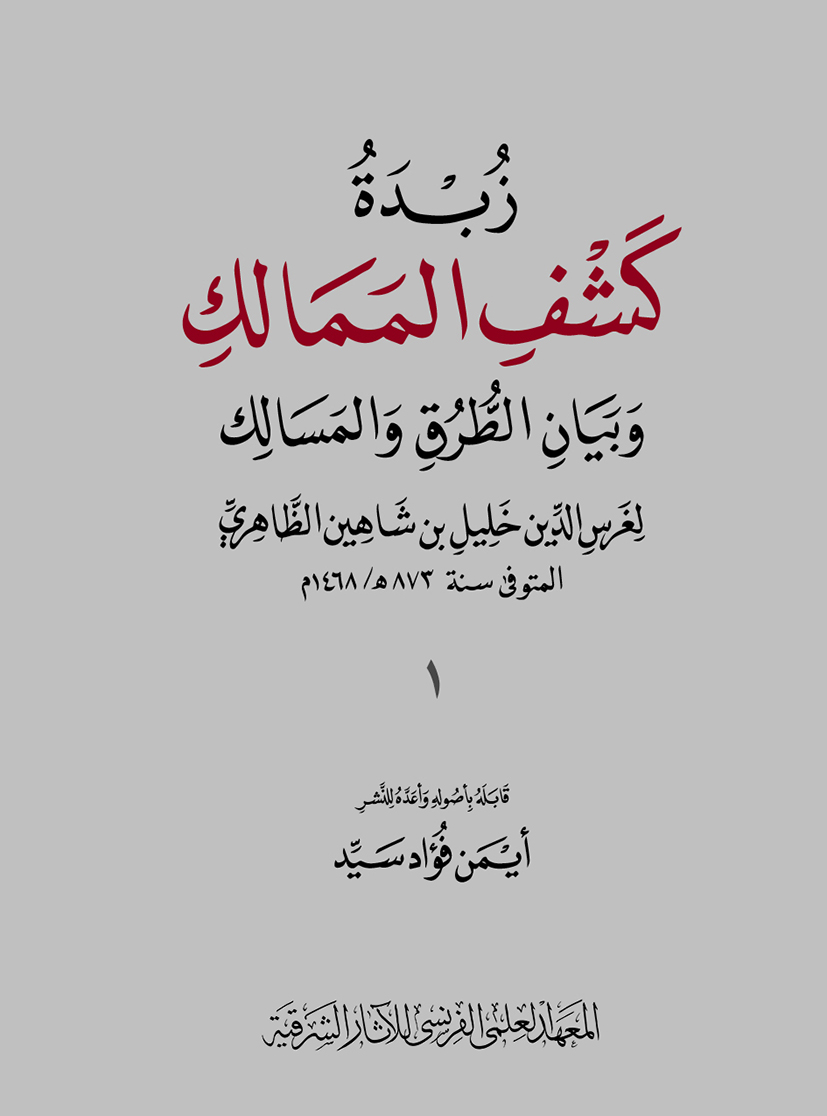
Ayman Fuʾād Sayyid
زُبْدَةُ كَشفِ المَمَالِك وبَيَانِ الطُّرُقِ والمَسَالِك لِغَرسِ الدِّينِ خَليلِ بن شَاهِين الظَّاهِرِيِّ Zubdat Kašf al-Mamālik wa bayān al-ṭuruq wa-l-masālik de Ḫalil b. Šāhīn al-Ẓāhirī TAEI 62; 714 p. Zubdat Kašf al-Mamālik wa bayān al-ṭuruq wa-l-masālik de Ḫalil b. Šāhīn al-Ẓāhirī est un des ouvrages qui recensent les institutions et les cérémonials du sultanat mamelouk en Égypte dans le but de servir de référence aux employés de l’État et à ceux qui s’intéressent aux questions politiques et diplomatiques. Les nouvelles réglementations administratives et les nouveaux décrets introduits par le sultanat mamelouk ont nécessité l’existence d’ouvrages … [en savoir plus] 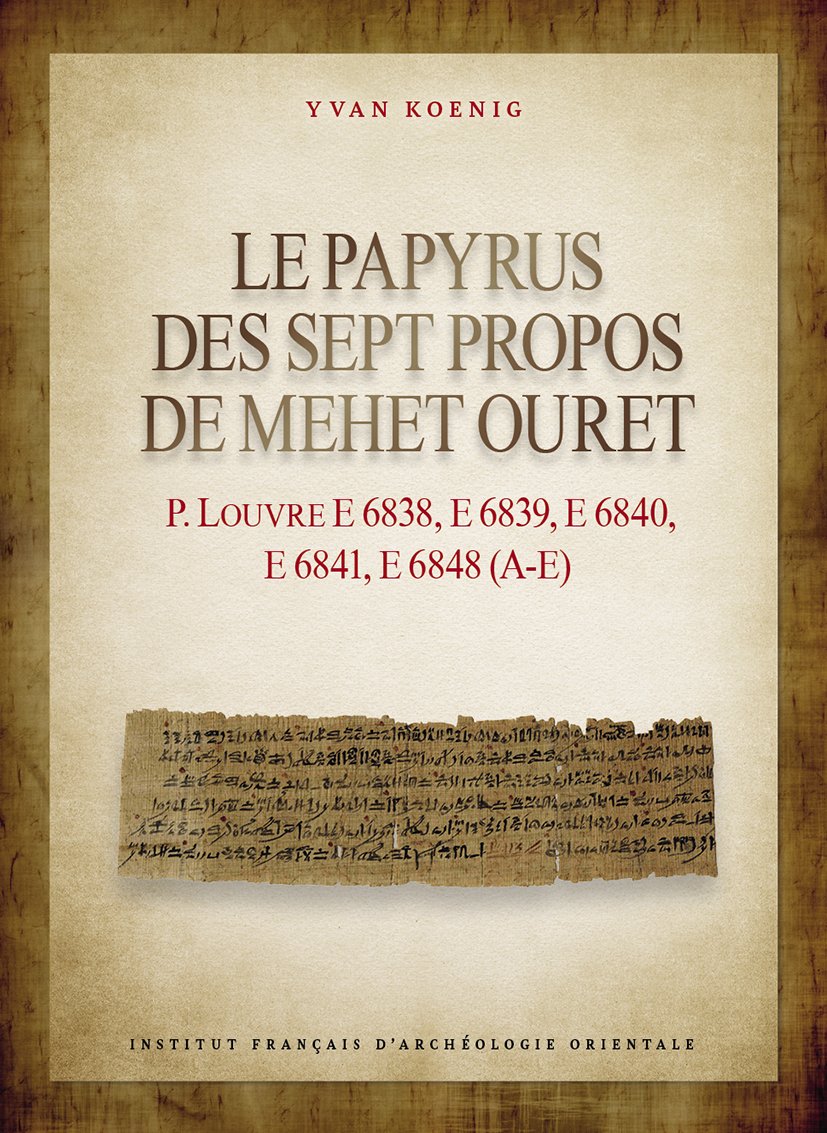
Yvan Koenig
Le papyrus des Sept Propos de Mehet Ouret P. Louvre E 6838, E 6839, E 6840, E 6841, E 6848 (A-E) BiEtud 189; 102 p. Le papyrus magique des Sept Propos de la vache Mehet Ouret se distingue par son originalité. Ce long papyrus est l’œuvre d’un « scribe du livre du dieu », le texte a été élaboré dans un temple à l’époque ramesside, comme l’indique la paléographie. La composition en est soignée : elle décrit le passage nocturne de la vache porteuse du disque solaire dans l’océan primordiale (le Noun). Ce parcours est divisé en plusieurs formules qui sont toutes construites sur le même … [en savoir plus] 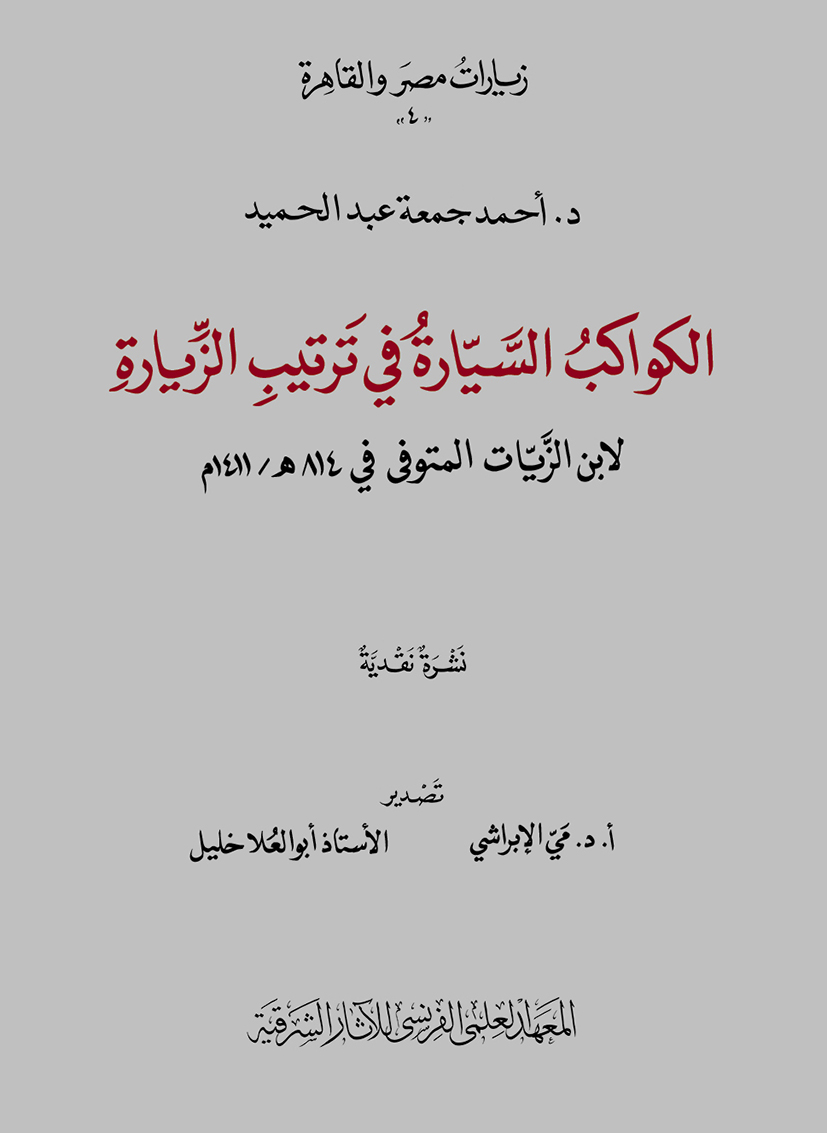
Ahmed Gomaa Abdelhamid
الكواكب السَّيَّارة في ترتيب الزِّيارة في القرافتين الصغرى والكبرى Les planètes en orbite pour l’organisation des visites dans la petite et la grande qarāfa TAEI 61; 672 p. Al-Kawākib al-sayyāra fī tartīb al-ziyāra (Les planètes en orbite pour l’organisation des visites) d’Ibn al-Zayyāt est incontestablement l’ouvrage de visites aux tombeaux le plus important et le plus complet. Son auteur a tiré bénéfice de l’expérience et des écrits de ses prédécesseurs, tels Muwaffaq al-Dīn ibn ʿUṯmān al-Šāriʿī (m. 615/1218), Ibn al-Nāsiḫ (m. après 696/1297) et Ibn al-Ǧabbās (m. après 736/1336). En outre, il a été … [en savoir plus] 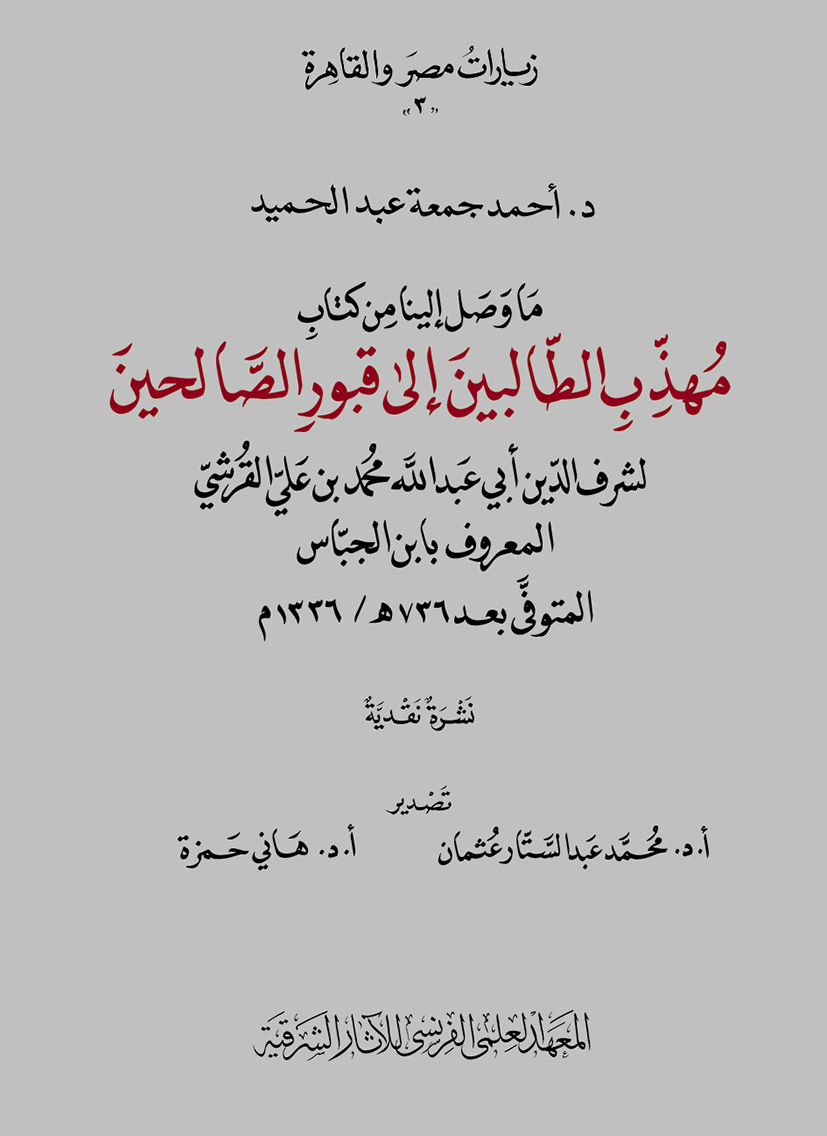
Ahmed Gomaa Abdelhamid
مُهذِّبِ الطّالبينَ إلى قبورِ الصّالحينَ لشرف الدّين أبي عبد الله محمد بن عليّ القُرشيّ المعروف بابن الجبّاس المتوفَّى بعد 736 هـ/1336 م TAEI 63; 314 p. Muhaḏḏib al-ṭālibīn īlā qubūr al-ṣāliḥīn (L’éducateur de ceux qui recherchent les tombeaux des pieux) d’Ibn al-Ǧabbās (m. après 736/1336) est le seul ouvrage traitant des visites aux tombeaux qui soit composé suivant le critère chronologique de la succession des générations (al-ṭabaqāt). Cette édition critique est basée sur un manuscrit rare écrit en Égypte et restauré par l'historien Šihāb al-Dīn b. al-ʿAǧamī, (m. … [en savoir plus] 
Christophe Corbier (éd.), Sibylle Emerit (éd.), Christophe Vendries (éd.)
De Villoteau à Saint-Saëns Une archéologie de la musique antique au XIXe siècle RAPH 48; 408 p. Le xixe siècle est un moment capital pour la connaissance des musiques de l’Antiquité : la découverte de fragments de notation musicale grecque et l’étude des traités des théoriciens sont l’occasion de revisiter la musique des Anciens, tandis que les fouilles conduites à Pompéi et en Égypte mettent au jour des vestiges d’instruments que l’on s’empresse de commenter. C’est désormais le temps des premières synthèses sur l’histoire de … [en savoir plus] 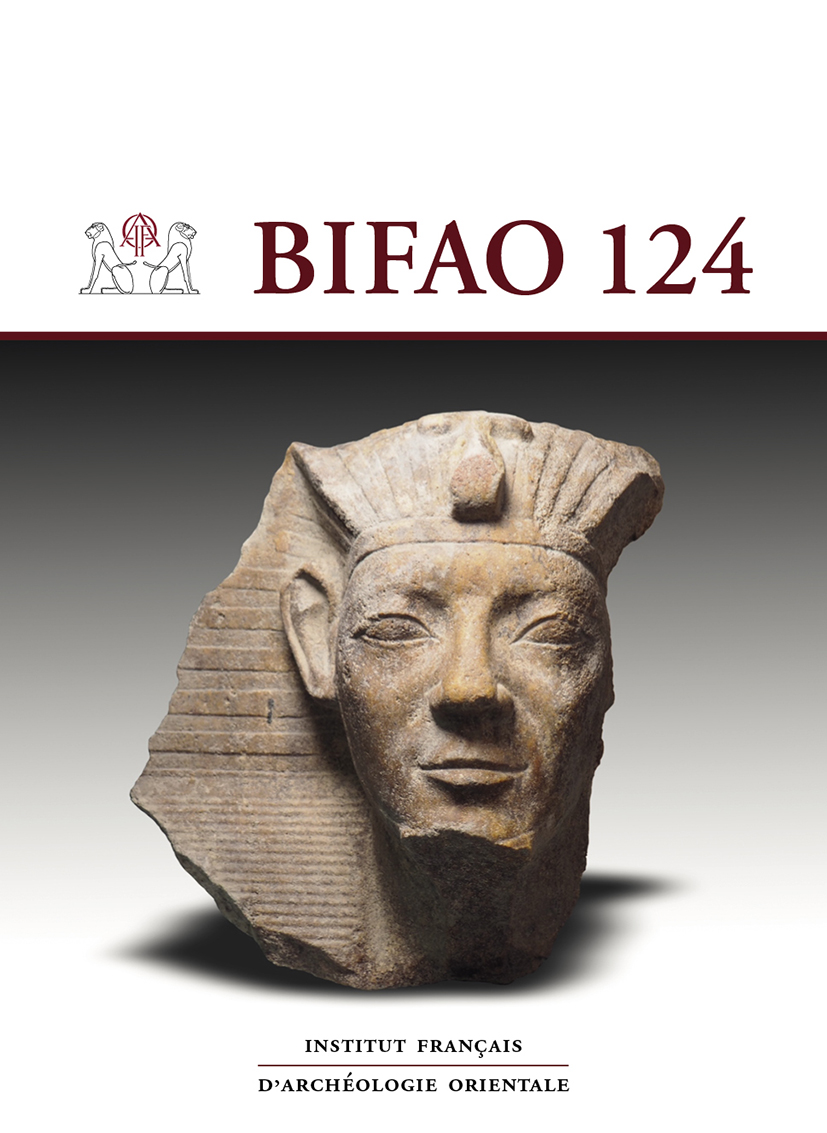
BIFAO 124 BIFAO 124; 442 p. Le Bulletin de l’Institut français d’archéologie orientale (BIFAO) couvre l’ensemble des champs de l’égyptologie depuis sa première publication en 1901. Les études qui y paraissent, dont l’aire chronologique s’étend de l’Égypte prédynastique jusqu’à l’époque byzantine, illustrent l’état des recherches actuelles dans les domaines de l’archéologie, l’épigraphie, la lexicographie, l’histoire de l’art, la religion et la philologie … [en savoir plus] 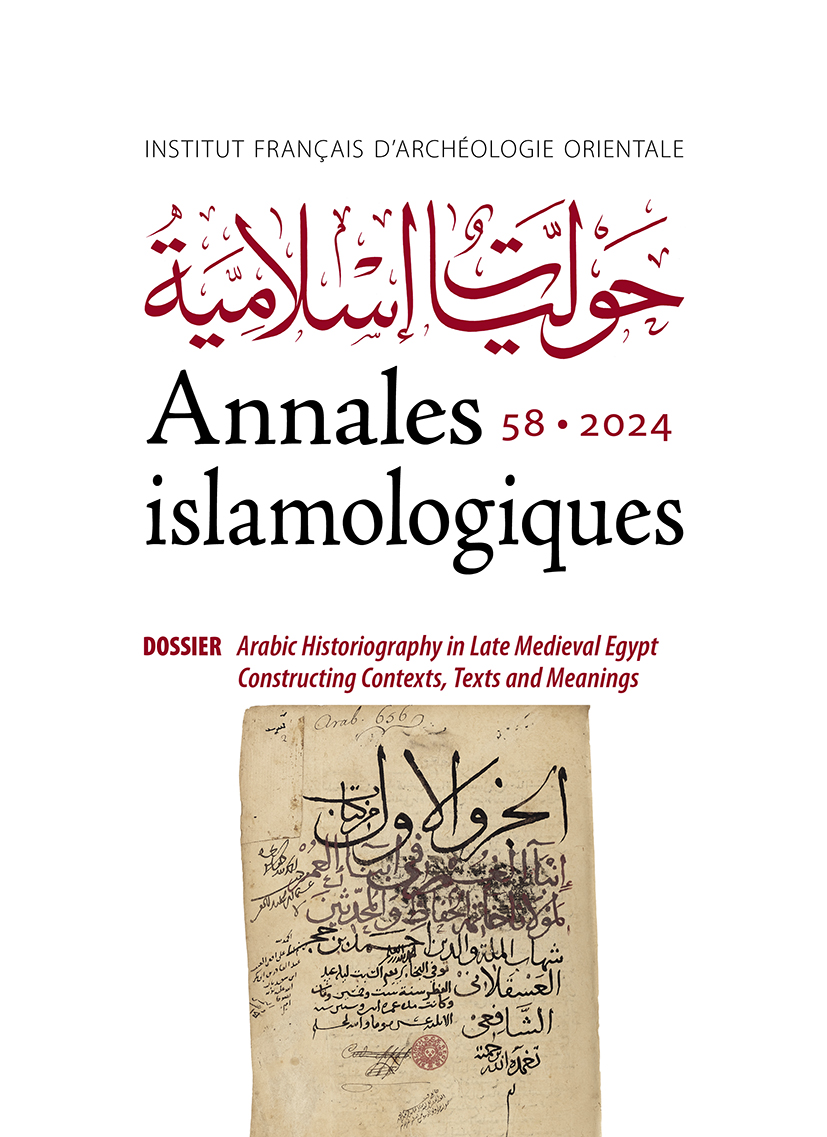
Annales islamologiques 58 Dossier : Arabic Historiography in Late Medieval Egypt: Constructing Contexts, Texts and Meanings. AnIsl 58; 294 p. Les Annales Islamologiques 58 proposent un dossier, coordonné par Jo Van Steenbergen et Maya Termonia, consacré aux riches traditions historiographiques arabes du sultanat du Caire (VIIe/XIIIe – Xe/XVIe siècle). Il porte en particulier sur les nombreuses dimensions contextuelles, textuelles et sémiotiques de la construction des mémoires sociales dans cette historiographie, dans le but d'approfondir la compréhension de la façon dont … [en savoir plus] 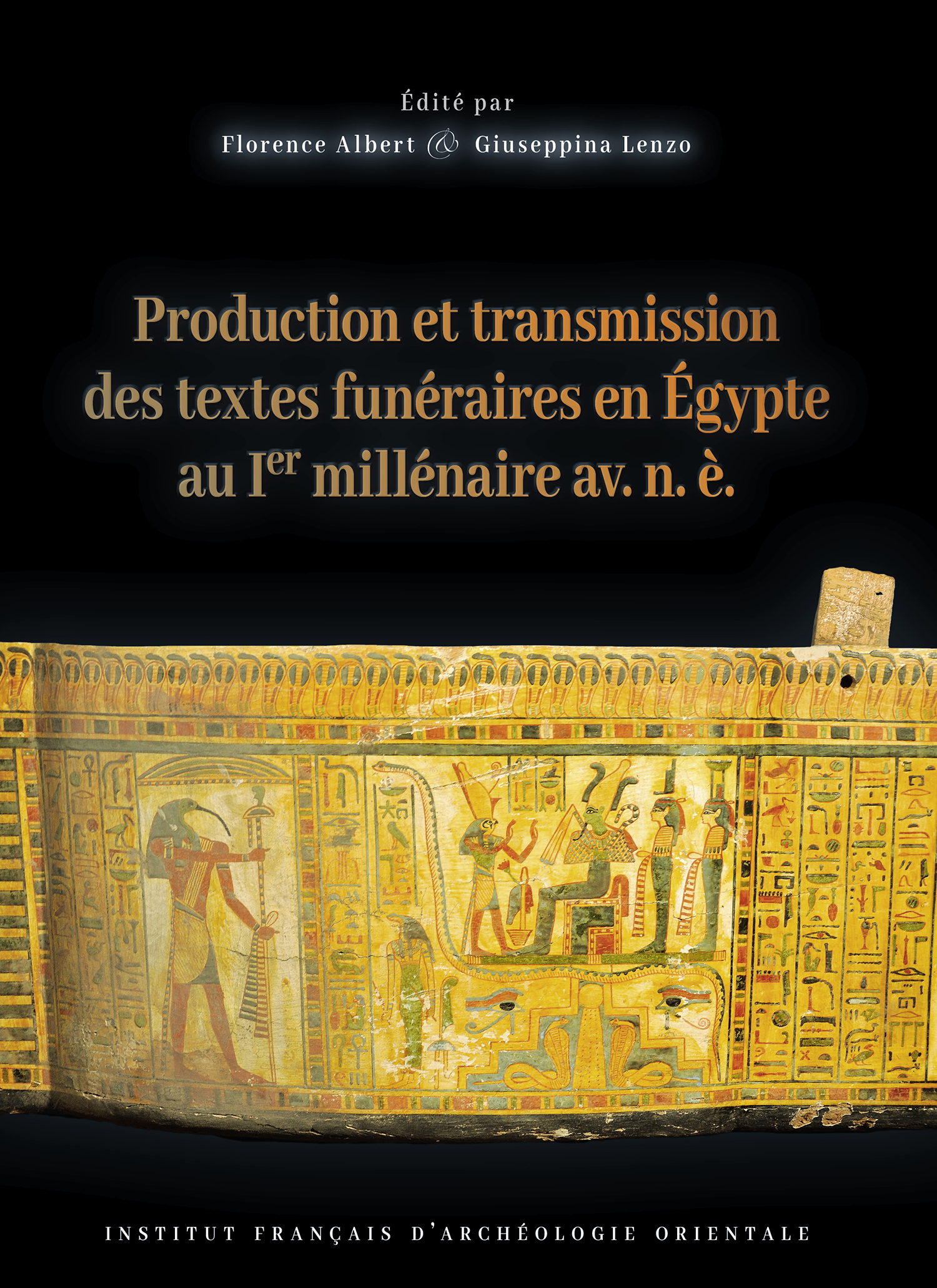
Florence Albert (éd.), Giuseppina Lenzo (éd.)
Production et transmission des textes funéraires en Égypte au Ier millénaire av. n. è. BiEtud 190; 320 p. Ce volume réunit douze contributions issues du colloque international « Les textes funéraires en Égypte au Ier millénaire av. n. è. : continuités et changements de la Troisième Période intermédiaire à la Basse Époque » qui s’est déroulé à l’université de Lausanne en septembre 2021, en partenariat avec l’Institut français d’archéologie orientale et l’université de Bâle. Les études présentées dans cet ouvrage concernent plus particulièrement les … [en savoir plus] 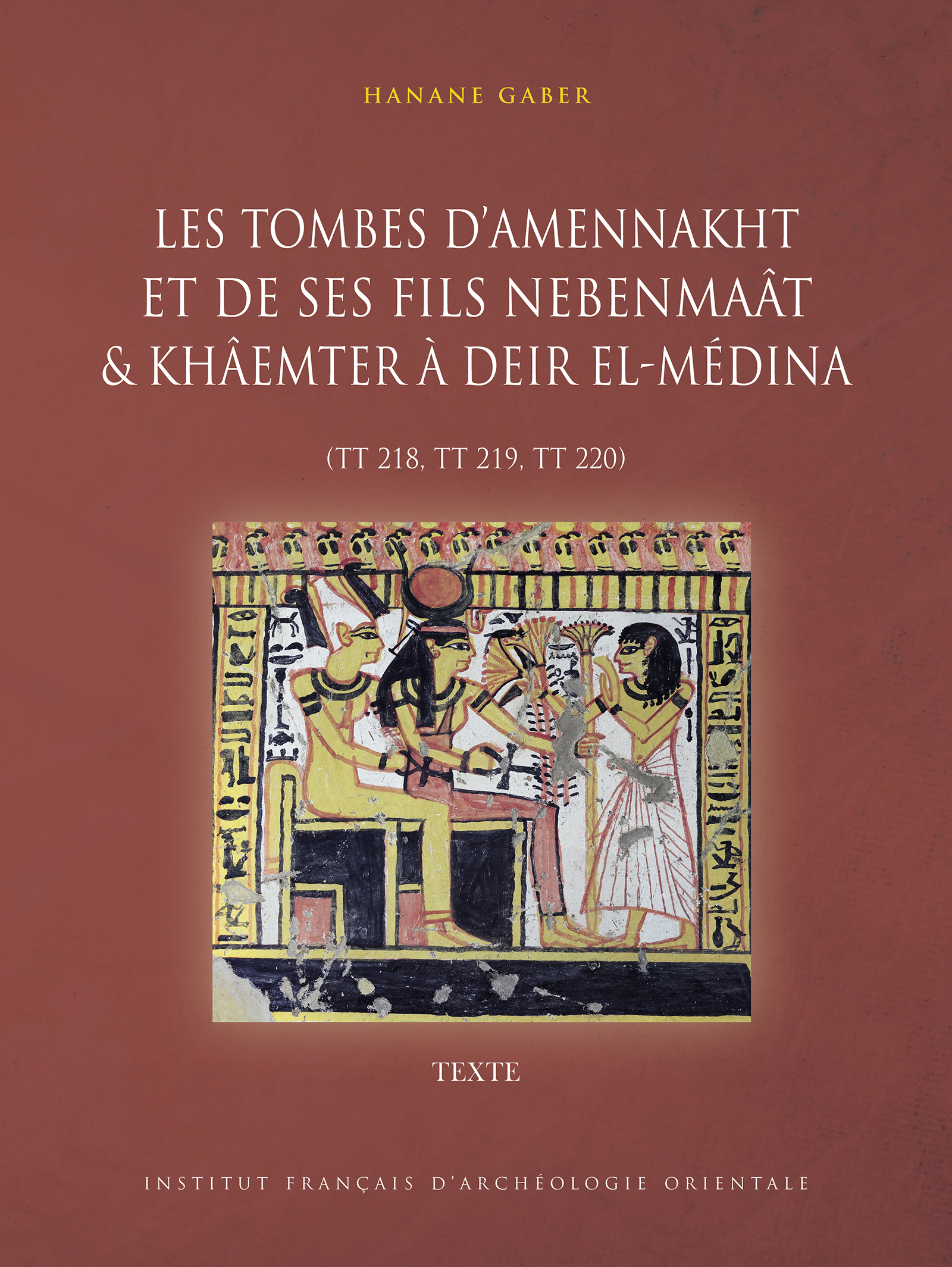
Hanane Gaber
Les tombes d'Amennakht et de ses fils Nebenmaât et Khâemter à Deir el-Médina (TT 218, TT 219, TT 220) MIFAO 153; 549 p. Les tombes d’Amennakht et de ses fils Nebenmaât et Khâemeter (TT 218-220), trois artisans qui vécurent sous les règnes de Séthy Ier et de Ramsès II, forment un complexe familial unique à Deir el-Médina et dans la nécropole thébaine. Cet ensemble se distingue tant par son architecture que par la décoration de ses pièces souterraines. L’édition de ces tombes comprend les relevés archéologiques, la … [en savoir plus] 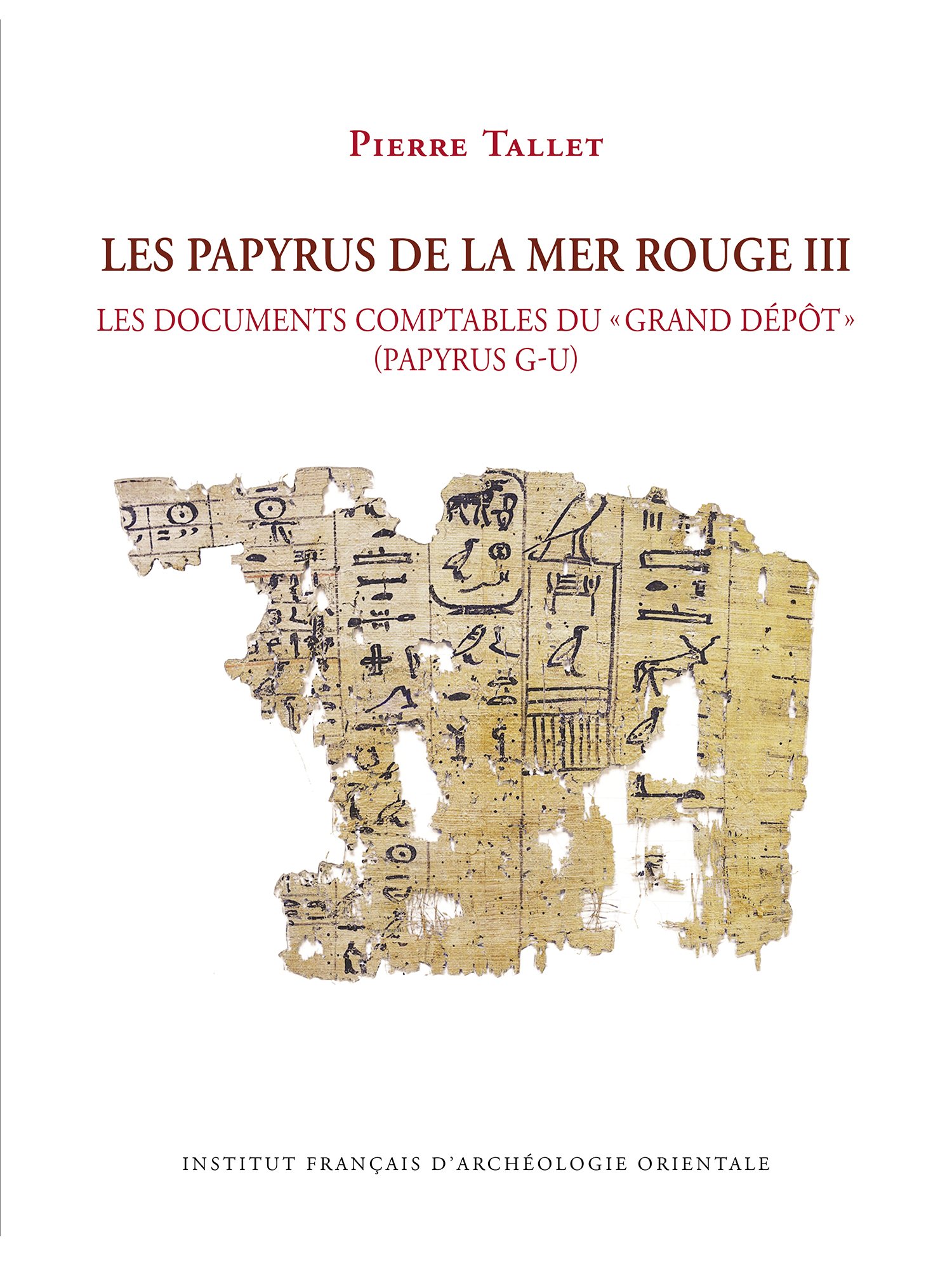
Pierre Tallet
Les papyrus de la mer Rouge III Les documents comptables du « grand dépôt » (papyrus G-U) MIFAO 156; 232 p. Ce troisième volume des « papyrus de la mer Rouge » consacré au lot de papyrus découverts en 2013 dans le « grand dépôt » laissé à l’avant des galeries G1 et G2 du site du Ouadi el-Jarf, s’attache à la publication des documents comptables les mieux préservés qui faisaient partie de cet ensemble. Quatorze des documents présentés ici (du papyrus G au papyrus T) correspondent ainsi, suivant différentes modalités, à l’enregistrement de denrées alimentaires, de matériel et … [en savoir plus] 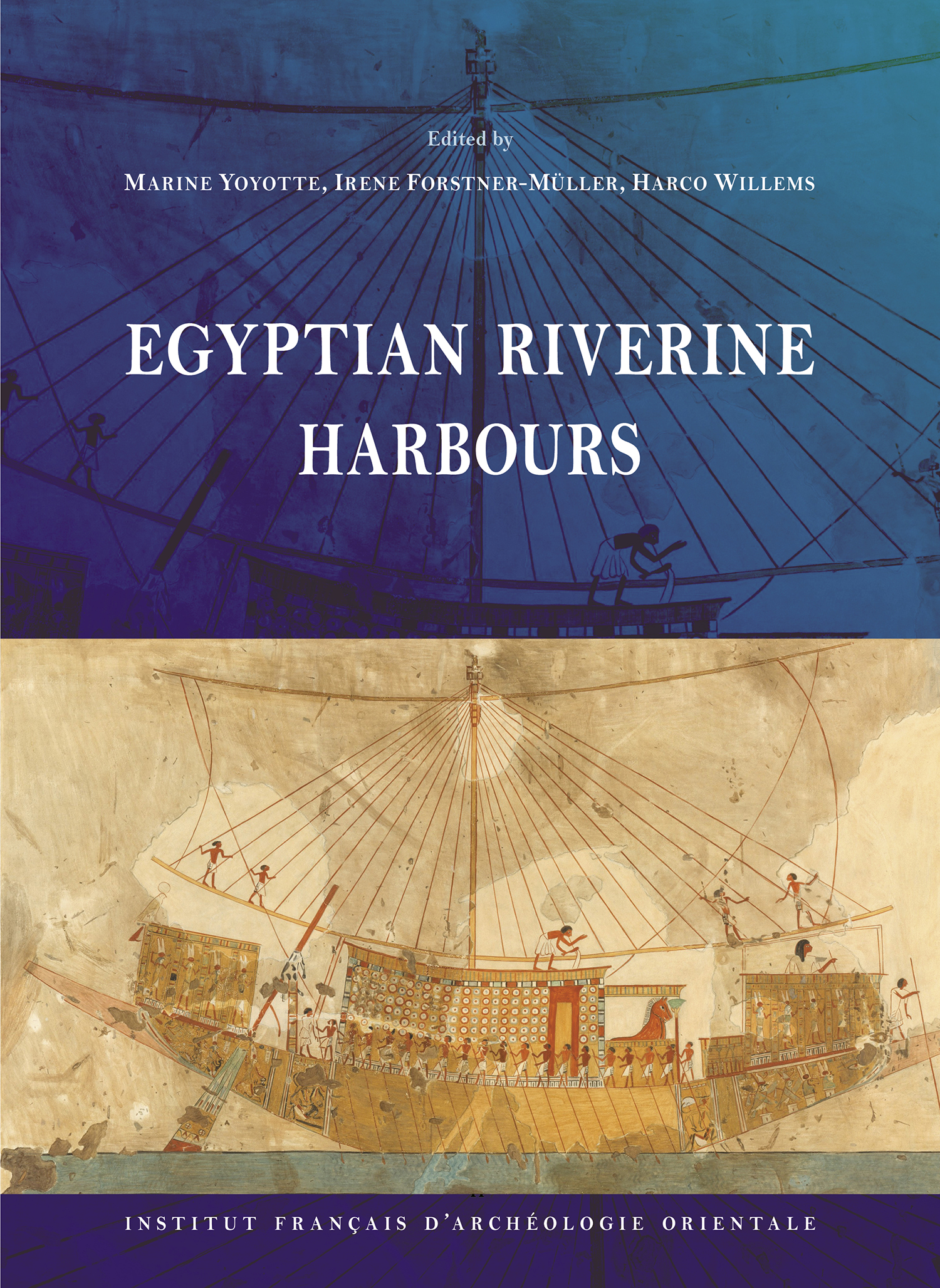
Marine Yoyotte (éd.), Harco Willems (éd.), Irene Forstner-Müller (éd.)
Egyptian Riverine Harbours Proceedings of the Symposium Held at IFAO, Cairo (15th-18th September 2019) BiEtud 188; 496 p. Ce livre contient les actes du premier colloque du groupe de travail « Egyptian Riverine Harbours », organisé à l’Ifao (Caire) du 15 au 18 septembre 2019. Ce groupe de travail, dirigé par Marine Yoyotte, Irene Forstner-Müller et Harco Willems, est le fruit d’une collaboration entre l’Ifao, l’OeAI (Caire) et l’université de KU Leuven. Ce volume rassemble dix-neuf contributions à la fois innovantes et interdisciplinaires allant de l’époque pharaonique au … [en savoir plus] |

IFAO Newsletter
January 2025
Sections: (-) Headlines (-)Life at the palace (-)Training and education (-) Some questions for Séverine Marchi... (-) IFAO notebook (-) Scientific Events (-) Scientific Meetings (-) On the Ifao YouTube channel (-) Publications

◼︎ Inauguration of the Hesyrê room at the Cairo Museum (room 27), October 12, 2024 © Ifao.
Headlines
|
All the staff at Ifao wish you an excellent 2025, full of happiness, fruitful collaboration and success. Inauguration of Hesyrê HallThe beginning of the new academic year was marked by the inauguration of the Hesyrê Room at the Cairo Museum (Room 27), which houses some of the most unique objects in the collections of this great museum: the wooden panels of the mastaba of Hesy-Rê. The work is the result of a joint project, led by Anita Quiles, between the Egyptian Museum in Cairo and the Ifao Department of Archaeometry, with the support of the French Institute in Egypt and the Michela Schiff Giorgini Foundation. The project included the study, restoration, conservation, and re-exhibition of Hesy-Rê's wooden panels in their original context, in order to allow museum visitors to enter a reconstructed part of Hesy-Rê's tomb, as conceived by its builders at Saqqara, which could not be preserved. The new room was inaugurated during a ceremony held at the museum on Saturday evening, 12 October, by the Secretary General of the Supreme Council of Antiquities, Dr. Mohamed Ismail, and the French Ambassador to Egypt, H.E. Mr. Eric Chevallier, in the presence of Dr. Zahi Hawas and Dr. Mamdouh el-Damaty, former Ministers of Antiquities. The event was attended by Prof. Moamen Osman, Head of the Museums Sector, Dr. Ali Abdel Halim, Director General of the Egyptian Museum, as well as ambassadors, directors of archaeological institutes in Egypt, university professors and public figures. Annual seminar of the Réseau des Écoles françaises à l'étrangerThe month of October ended with the annual seminar of the Réseau des Écoles françaises à l'étranger, held in Paris at the headquarters of the École française d'Extrême-Orient. It was dedicated to the archives of the institutes, ten years after the first meeting on this subject. A presentation of the Ifao's archives and collections by Cédric Larcher, who has been in charge of the department since 2016, gave an overview of the development of the collections (administrative and research archives) and the progress made in terms of collection, storage, conservation, accessibility and presentation. The Archives and Cultural Heritage Mission of the Ministry of Higher Education and Research and the National Archives contributed to the discussions. The meeting will lead to new network-wide initiatives to raise awareness among researchers (structuring and archiving research data) and to disseminate a wealth of documentation on the history of the institutes and their fields of study. The Exploring Egypt Seminar expands its partnershipLaunched in 2023 as a joint initiative of the Ifao and the DAIK, the ‘Exploring Egypt Seminar: Histories and Historiographies’ expands the partnership for the organisation and hosting of the sessions in 2025 to the CAI (Centro Archeologico Italiano), the PCMA (Polish Centre of Mediterranean Archaeology Cairo) and the NVIC (Netherlands-Flemish Institute in Cairo). The first session was held at the CAI Champollion st. on 15 January, and a second will be hosted by the DAIK on 22 January. The seminar, organised by Fatma Keshk and Malak Labib, aims to discuss various aspects of the production of historical knowledge about Egypt and seeks to bring together fields that have traditionally been examined separately, such as the history of Egyptology, the study of modern Egyptian historiography and the history of heritage and preservation. World Urban ForumIn early November 2024, the gardens of the Ifao hosted an evening event organized by the French Embassy in Egypt following a session of the 12th World Urban Forum (Cairo, 4 to 8 November 2024) held at the IFE, with the participation of H.E. Mr. Thani Mohamed-Soilihi, Secretary of State for the Francophonie and International Partnerships, who came to attend this important international meeting and opened the evening with a speech.
|
◼︎ Pierre Tallet gives a speech at the inauguration of Salle Hesyrê ©I. Ibrahim/Ifao
◼︎ Hesyrê room 27 ©I. Ibrahim/Ifao
◼︎ Presentation of the Ifao archives and collections by Cédric Larcher ©A.Bahgat/Ifao
◼︎ S.E.M. Thani Mohamed-Soilihi ©A.Bahgat/Ifao |
|
News about the Archaeological Sites and Programs17 archaeological and epigraphic fieldwork missions were carried out in the second half of 2024: in addition to the missions to Tebtynis, Tanis, South Sinai, Tell el-Herr, Hatnoub, Kom Ombo, Ermant, Saqqara, Assassif, Cairo Citadel, Islamic funerary stelae, Tell el-Iswid, Kharga and Konosso, the missions to Taposiris Magna, Coptos and Dendera epigraphy took place despite being postponed. The Kôm Abou Billou mission did not have any fieldwork. The mission to Dendara metropolis was suspended, and that to Gourob cancelled. |
||
|
The Cairo Citadel mission is one of the Ifao's new field operations. It is part of the Ifao's efforts to develop medieval archaeology in Egypt. It follows the work carried out previously at Fustat and on the Cairo Walls, as well as the promising epigraphic research carried out by the team, led by Abbès Zouache and Ahmed Elshoky, on the ‘Islamic funerary stelae’ epigraphic mission. The first excavation campaign carried out this year by the Cairo Citadel mission was undertaken at the presumed junction of the Ayyubid/Mamluk aqueduct and the Citadel, to the south of the latter. A network of previously unknown saqia towers was uncovered. It was used to bring water up from the aqueduct to the fortress. A new video presenting the Ifao's archaeological missions has just been published. Directed by Amr Bahgat, it presents the excavations of the Taposiris Magna and Plinthine Mission, led by Berangère Redon, on the Taposiris Magna site, where the excavations are coordinated by Joachim le Bomin, co-director of the mission.
 ◼︎ Excavations at the Cairo Citadel © Ihab Ibrahim/Ifao. ◼︎ Excavations at the Cairo Citadel © Ihab Ibrahim/Ifao. |
||
Life at the palace
Art Book & Print Workshop, Imprimerie Nationale, ParisLilian Amin and Hany Mouawad spent a week at the Atelier du Livre d'Art & de l'Estampe de l'Imprimerie Nationale in Paris. A week rich in exchanges and learning about the machines and their maintenance, and about the practices and activities in their respective workshops. Thanks to Hani Moawad's expertise, the Imprimerie Nationale's equipment (Supra and Monotype keyboard) was even restored to working order. An opportunity to remember how fragile the preservation and transmission of know-how can be, and how essential collaboration and exchange are in professions that have become rare. A partnership that opens up excellent prospects for future cooperation between the Ifao and the ALAE.
Restoration of an exceptional chandelierWe are delighted to announce the successful restoration of an exceptional eighteen-branch Murano crystal chandelier, acquired by the Ifao in the 1950s and hanging in the salon ever since. This precious object, whose state of preservation had deteriorated considerably over the years, has been restored to its former glory thanks to the joint efforts of the Archives and Collections teams, in collaboration with Conservation Gallery. This painstaking work has given new life to an important piece of our heritage. |
◼︎ Lilian Amin and Hany Mouawad
◼︎ An exceptional eighteen-branch chandelier in Murano crystal. ©A.Bahgat/Ifao |
Training and Education
|
In the autumn of 2024, the Ifao's various annual courses and trainings were back in session: Akhet and Peret seminars for employees of the Ministry of Tourism and Antiquities; Ifao courses for French speakers (on the theme “War and Peace. Egypt and its neighbors from ancient to modern times"). The small group who started the Introduction to Hieroglyphics course last spring continued to meet in the second half of 2024, while another cycle opened for some fifteen new beginners. The eighth edition of the Académie hiératique, organized by Annie Gasse and Nathalie Sojic, brought together a small group of doctoral students on the theme “Le texte et ses à-côtés : annotations, corrections et illustrations dans les ostraca littéraires inédits de Deir el-Medina conservés à l'Ifao”. A new academy for young researchers was launched in early December by Simon Connor and Axelles Brémont: “l'Académie de l'image”. The first edition brought together a group of young Egyptology researchers for a week at the institute, with the aim of training them in the methods of art history. Specific training courses were also held. From 16 to 27 July, a summer school in Islamology ("Arabic through the texts of Islamic tradition"), jointly organized by Ideo, Ifao and IFI, brought together twelve students at the Masters and PhD levels, who benefited from lectures by professors from Al-Azhar University. On November 24 and 25, IFAO and CFEETK, in partnership with the Ministry of Tourism and Antiquities, organized two methodological workshops on scientific research and publication, respectively at the Abydos Inspectorate, in collaboration with Dr. Mohammed Naguib, Director of Sohag Antiquities, and at the Luxor Museum, in collaboration with its Director, Dr. Alaa El-Menshawy. For the first time, a joint conference was organized with the Centro Archeologico Italiano (CAI) on Champollion Street in the city center. The latter has been particularly active since the appointment of Prof. Giuseppe Cecere as director last April. Camille Rouxpetel, PI of the ERC project 'ChrIs-cross', gave a lecture entitled 'Restoring the Holy Places under the Mamluk Sultanate' at the CAI on Wednesday 6 November at 6 pm. Wednesday 15 January saw the first day of the ‘Writing modern history’ training course. The course, run by Dina Bakhoum, Antoinette Ferrand & Amr Khairy, brought together eight Egyptian historians at the start of their careers who are working on subjects relating to the modern history of Egypt. The course comprises 6 sessions and will run until June 2025, at the rate of one session per month. |
◼︎ Training workshop at Abydos.
◼︎ L'académie de l'image. ©A.Bahgat/Ifao
◼︎ ‘Writing modern history' workshop © Dina Bakhoum, Ifao |
Some questions for Séverine Marchi...
|
Séverine Marchi is a CNRS archaeologist and a statutory member of UMR 8167 - Orient et Méditerranée (Pharaonic Worlds team). Since 1998, she has taken part in several archaeological missions in Egypt (Sinai, Karnak, Wadi el-Jarf) and Sudan (Gism el-Arba, Zankor-Abou Sofyan, Sedeinga, Doukki Gel). Appointed by the French Ministry of Europe and Foreign Affairs in 2023, she heads the French Section of the Sudan Antiquities Authority (SFDAS - UMIFRE 4 / UAR 3336 - Afrique au sud du Sahara). |
||
1.Séverine Marchi, you've been head of SFDAS since 2023. Can you tell us about your appointment and tell us about SFDAS's main activities?I was appointed head of the French Section of the Sudan Antiquities Authority just before the outbreak of war, in April 2023. The conflict forced us to suspend all activities until the institute was redeployed to Cairo and Faïza Drici and I arrived at Ifao. From 1969 to 2023, SFDAS was the only French archaeological research institute permanently based in Khartoum. We are one of 27 French overseas research institutes (IFRE), funded by the MEAE and the CNRS, and part of the Sudan Antiquities Service (National Corporation for Antiquities and Museums). For over 55 years, the Institute's mission has been to contribute to the study of the history of ancient Sudan, to the enhancement of the country's archaeological heritage, and to its protection and presentation to the public. Our research focuses on the major periods of Sudanese history: the Neolithic, the Kingdom of Kerma, the Egyptian conquest of Nubia and the kingdoms of Napata and Meroe. We therefore coordinate scientific cooperation projects between France and Sudan, and in the absence of any possibility of working in the field, we have had to redirect our actions in particular towards supporting the community of exiled researchers or those who have stayed behind, by offering research grants, for example. 2.There are long-standing links between Ifao and SFDAS, and the Mounira Palace has been enriched by hosting SFDAS since December 2023. Can you please tell us about these links and the circumstances of this move from Khartoum to Cairo? |
|

◼︎ Séverine Marchi |
|
The extremely warm welcome we received from the entire Ifao team alleviated the logistical difficulties we had to face when relocating. The installation of an office in the heart of the palace allows us to welcome our colleagues comfortably, to offer conferences on Sudanese archaeology and to take part in the many activities offered by the institute. Sudanese researchers are always welcomed at Ifao with kindness and goodwill, and exchanges with Egyptologist and Arabist colleagues are very enriching. Given the current rather complicated situation, the conditions have been right at Ifao for us to be able to work serenely, and I would like to thank everyone here once again.
3.And beyond that, what impact has the war in Sudan had on SFDAS's activities?The war that has been raging for the past year and a half has had a severe impact on archaeology, heritage preservation and academic circles. The destabilization of the country's authorities and the insecurity affecting all regions of Sudan have resulted in an almost total halt to scientific and academic activities. The situation has been extremely difficult for researchers and students, who have been forced to migrate to other parts of the country, and for some, forced expatriation to neighbouring countries such as Egypt. The relocation to Cairo prompted SFDAS to review its strategy and restructure the programs that had been initiated before the war. In collaboration with NCAM, for example, we are developing a WebGIS project to monitor endangered archaeological sites (looting, gold panning, expansion of agricultural crops, war). At the same time, we are working on the creation of a virtual museum for the National Museum of Khartoum, whose collections were looted in 2024, thus contributing to the fight against the trafficking of cultural goods. Our proposals for reorienting our research activities and our actions to promote and protect Sudanese heritage are designed to keep the institute running from an external operational base, pending a return to Sudan. |
||
4.In addition to your work for SFDAS, you also take part in a number of Ifao archaeological missions. Can you tell us a little about them?I started working in Egypt the same year as in Sudan. That was over 25 years ago, at the Tell el-Herr site in northern Sinai. Since then, I've worked regularly with Ifao teams such as the Wadi el-Jarf mission led by Pierre Tallet. Since 2015, I've been lucky enough to be able to excavate the storage galleries in which the ships of the Cheops fleet and associated nautical equipment were stored. It's an exceptionally rich site studied by an equally rich team. Since 2018, I've also been taking part in the Taposiris Magna-Plinthine mission led by Bérangère Redon, where I'm excavating the Saito-Persian habitat levels of Plinthine. And this year I joined Pierre's team working in South Sinai. So my links with the Ifao are strong. It's a real pleasure to be able to take part in the life of this great establishment that has so warmly welcomed our institute. |
||
Ifao notebook
Arrivals- Antoinette Ferrand, historian of modern Egypt, has been recruited as a scientific member. Her project focuses on the construction of Egyptian national identity. - Aurore Ciavatti, has been the new Head of the Library since September 2024. - Agnès Macquin, has been recruited as Head of the Promotion Unit, Open Science Referent and Eco-Responsibility Referent. - Claude Valoris is the new head of the IT and digital humanities department. - Coumba Gerente joined Ifao in September as Human Resources Manager, responsible for French rights and European projects. - Christophe Vendries, Professor of Roman History at the University of Rennes II, LAHM/Creaah/UMR 6566, is a visitor scholar at the Ifao from September 2024. |
|
◼︎ Claude Valoris
◼︎ Coumba Gerente  ◼︎ Christophe Vendries ◼︎ Christophe Vendries |
Scientific events
 |
Les conférences de l'Ifao lectures Series |
|
|
|
|
Ifao research seminar |
|
|
|
|
Lecture series: Egyptology Bi-L-ʿarabīOrganised in partnership with "Al-Makân wa-l-Nâs" |
|
 |
Les rendez-vous de l'archéologie lectures SeriesOrganised in partnership with IFE |
|
|
Workshops
 |
From 17th to September 29th 2024, Training by Mathilde Prevost: Akhet Seminar on current developments and methods in Ancient Egyptian history and archaeology, in partnership with Central Traning Unit - MoTA [more] |
|
 |
On September 20th 2024, Research Workshop by : Atelier Des métiers en Égypte ancienne ? Métiers et savoirs-experts en Égypte ancienne [more] |
|
 |
From September 29th to October 3rd 2024, IFAO Academies for Young Researchers by Annie Gasse & Nathalie Sojic: 8e Académie hiératique : Le texte et ses à-côtés : annotations, corrections et illustrations, in partnership with ENiM, UMR 5140 – ASM, Université Montpellier 3 [more] |
|
 |
On November 25th 2024, Training by Jérémy Hourdin, Ahmed Mekawy Ouda, Mathilde Prévost & Anaïs Mauriceau: Research and publication in Egyptology: a methodological introduction, in partnership with CFEETK, MoTA [more] |
|
 |
On January 15th 2025, Training by Dina Bakhoum, Antoinette Ferrand & Amr Khairy: Writing Modern History [more] |
|
 |
From 9th to December 14th 2024, IFAO Academies for Young Researchers by Axelle Brémont, Simon Connor, Gabriele Pieke: Academy of Egyptian images [more] |
Exceptional Events
 |
On October 10th 2024, Lecture by Katarína Arias Kytnarová & Olena Romanova: , in partnership with Embassy of the Czech Republic & Embassy of Ukraine in Cairo [more] | |
 |
On October 23rd 2024, Keynote Lecture by Waleed Arafa: The Sacred in Architecture, in partnership with EPHE, PSL, histara [more] | |
 |
On November 6th 2024, Lecture by Camille Rouxpetel: Restoring the Holy Places under the Mamluk Sultanate, in partnership with Instituto italiano di cultura, CNRS, ERC COG “ChrIs-Cross” [more] | |
 |
On November 7th 2024, Book presentation by Prof. Fayza Haikal, Prof. Emad Abou Ghazi & Dr Fatma Keshk: Présentation des Agendas de l’Ifao 2025 [more] |
SFDAS conferences
Scientific meetings
 |
From 23rd to October 24th 2024, International conference organized by Fatma Keshk & Sabine Frommel: A Church, A Mosque: Interdisciplinary conversations between architecture and art history International Conference [more] | |
 |
From 3rd to December 4th 2024, International conference organized by : المتاحف المستدامة والذكية: الاستراتيجيات، الممارسات والتحديات, in partnership with كلية الآثار بجامعة عين شمس وقطاع المتاحف، المجلس الأعلى للآثار بوزارة السياحة والآثار. [more] | |
 |
From 5th to December 6th 2024, Research Workshop by : CONSTITUTIONS, in partnership with EFR, EFA et EFEO [more] |
On the YouTube channel
Publications

Ayman Fuʾād Sayyid
زُبْدَةُ كَشفِ المَمَالِك وبَيَانِ الطُّرُقِ والمَسَالِك لِغَرسِ الدِّينِ خَليلِ بن شَاهِين الظَّاهِرِيِّ Zubdat Kašf al-Mamālik wa bayān al-ṭuruq wa-l-masālik de Ḫalil b. Šāhīn al-Ẓāhirī TAEI 62; 714 p. [more] 
Yvan Koenig
Le papyrus des Sept Propos de Mehet Ouret P. Louvre E 6838, E 6839, E 6840, E 6841, E 6848 (A-E) BiEtud 189; 102 p. The magical papyrus of the Seven Propositions of the cow Mehet Weret stands out for its originality. This long papyrus is the work of a "scribe of the divine book", the text having been drawn up in a temple during the Ramesside period, as revealed by the paleography. The composition is meticulous: it describes the nocturnal passage of the cow carrying the solar disk through the primordial ocean (the Nun). This journey is divided into several stages, all built on the same model. In each case, … [more] 
Ahmed Gomaa Abdelhamid
الكواكب السَّيَّارة في ترتيب الزِّيارة في القرافتين الصغرى والكبرى Les planètes en orbite pour l’organisation des visites dans la petite et la grande qarāfa TAEI 61; 672 p. Ibn al-Zayyāt’s al-Kawākib al-sayyāra fī tartīb al-ziyāra (Orbiting Planets for Organising Visits) is certainly the most comprehensive and systematic, and overall most important work on visiting tombs. Its author wrote his work more than seven and a half centuries after the foundation of the first cemetery of the qarāfa. He built on the experience of his predecessors, such as Muwaffaq al-Dīn ibn ʿUṯmān al-Šāriʿī (d. 615/1218), Ibn al-Nāsiḫ (d. … [more] 
Ahmed Gomaa Abdelhamid
مُهذِّبِ الطّالبينَ إلى قبورِ الصّالحينَ لشرف الدّين أبي عبد الله محمد بن عليّ القُرشيّ المعروف بابن الجبّاس المتوفَّى بعد 736 هـ/1336 م TAEI 63; 314 p. Unique among the extant works on visiting tombs, the Muhaḏḏib al-ṭālibīn ilā qubūr al-ṣāliḥīn (The Educator for Seekers of Tombs of the Pious), by Ibn al-Ǧabbās (d. after 736/1336) is the only book that is organised by generations (ṭabaqāt). This critical edition is based on a rare manuscript copied in Egypt and restored by Šihāb al-Dīn b. al-ʿAǧamīʿ, the historian and visitor (d. 1086/1675) who owned it. We do not know precisely when it … [more] 
Christophe Corbier (éd.), Sibylle Emerit (éd.), Christophe Vendries (éd.)
De Villoteau à Saint-Saëns Une archéologie de la musique antique au XIXe siècle RAPH 48; 408 p. The 19th century is a key period for the study of music in antiquity: it was during this time that fragments of Greek musical notation and theorists’ treatises were (re-)discovered, while excavations in Pompeii and in Egypt brought to light important remains of musical instruments. Some of the first syntheses on the history of music were written under the leadership of Belgian, English, French, German, Italian scholars. Composers and artists who were … [more] 
BIFAO 124 BIFAO 124; 442 p. The Bulletin of the French Institute of Oriental Archaeology (BIFAO), which made its first appearance in 1901, covers all fields of Egyptology. Studies published in the BIFAO, extending chronologically from prehistory to the Byzantine period, illustrate the present state of research in the disciplines of archaeology, epigraphy, lexicography, history of art and philology. more] 
Annales islamologiques 58 Dossier : Arabic Historiography in Late Medieval Egypt: Constructing Contexts, Texts and Meanings. AnIsl 58; 294 p. This volume engages with the rich Arabic historiographical traditions of the Sultanate of Cairo (VIIth/XIIIth – Xth/XVIth centuries). It focuses in particular on the many contextual, textual and semiotic dimensions of the construction of social memories in this historiography, aiming to further understandings of how these dimensions connected texts of history in diverse ways to the social, cultural and above all political environments of their production, reception and circulation. It engages … [more] 
Florence Albert (éd.), Giuseppina Lenzo (éd.)
Production et transmission des textes funéraires en Égypte au Ier millénaire av. n. è. BiEtud 190; 320 p. This volume gathers twelve contributions from the international colloquium "Funerary Texts in Egypt during the First Millennium BCE: Continuity and Change from the Third Intermediate Period to the Late Period", which took place at the University of Lausanne in September 2021, in partnership with the Institut français d'archéologie orientale and the University of Basel. The articles presented in this book focus on the funerary texts of the Third Intermediate Period (1069-664 BCE) and the Late … [more] 
Hanane Gaber
Les tombes d'Amennakht et de ses fils Nebenmaât et Khâemter à Deir el-Médina (TT 218, TT 219, TT 220) MIFAO 153; 549 p. The tombs of Amennakht, Nebenmaat and Khameter (TT 218-220), three craftsmen who lived under the reign of Sethy I and Ramesses II, form a unique familial complex in Deir el-Medina and in the Theban necropolis. This complex is distinguished both by its architecture and by the decoration of its underground funerary chambers. The edition of these tombs includes archaeological records, description of the scenes, translation of the texts, … [more] 
Pierre Tallet
Les papyrus de la mer Rouge III Les documents comptables du « grand dépôt » (papyrus G-U) MIFAO 156; 232 p. This third volume of “Red Sea papyri”, devoted to the group of papyri discovered in 2013 in the “large deposit” in front of caves G1 and G2 at the Wadi el-Jarf site, focuses on the publication of the best-preserved accounting documents that were part of this ensemble. Fourteen of the documents presented here (from papyrus G to papyrus T) relate, in different ways, to the recording of foodstuffs, equipment and tools made available to the teams working in this … [more]

Marine Yoyotte (éd.), Harco Willems (éd.), Irene Forstner-Müller (éd.)
Egyptian Riverine Harbours Proceedings of the Symposium Held at IFAO, Cairo (15th-18th September 2019) BiEtud 188; 496 p. This book is the proceedings of the first symposium of the working group "Egyptian Riverine Harbours", held at Ifao (Cairo) from 15 to 18 September 2019. This working group, led by Marine Yoyotte, Irene Forstner-Müller and Harco Willems, is part of a collaboration between IFAO, OeAI (Cairo branch) and KU Leuven. The volume brings together nineteen both innovative, interdisciplinary contributions from the Pharaonic period to the Middle Ages, representing the first attempt yet to … [more] |


















